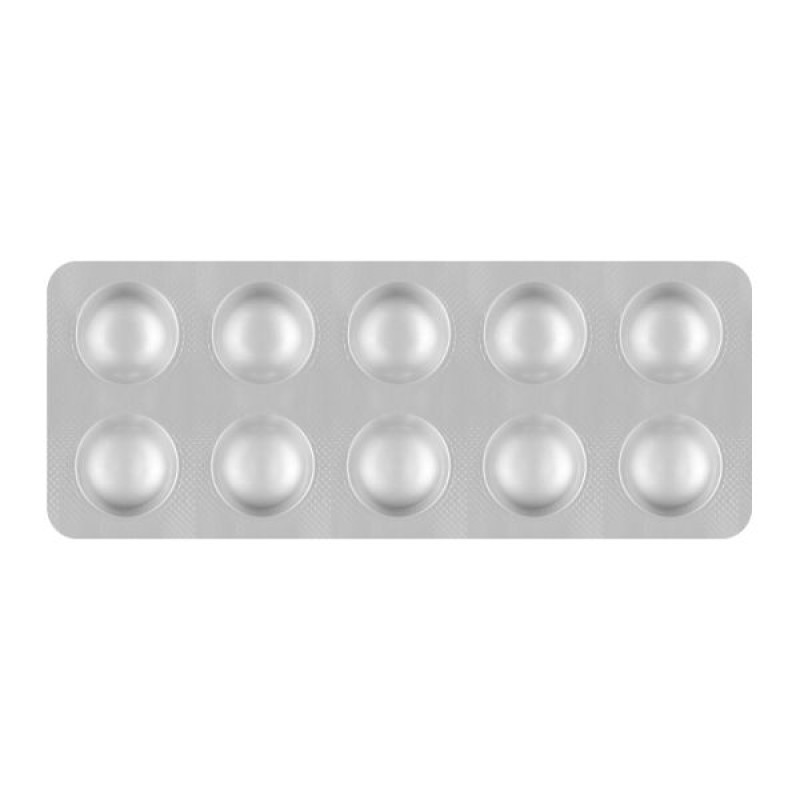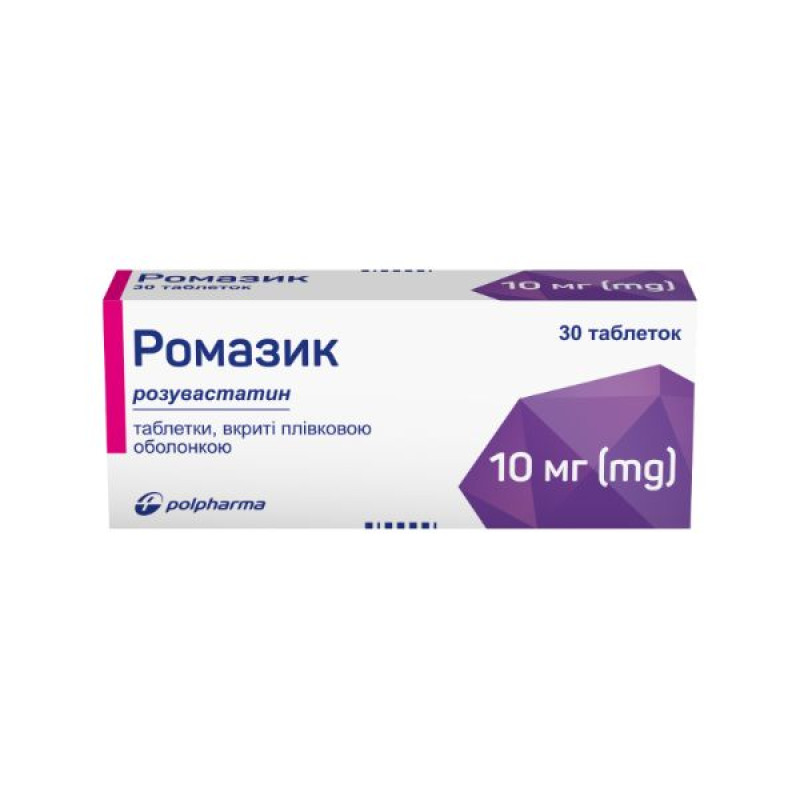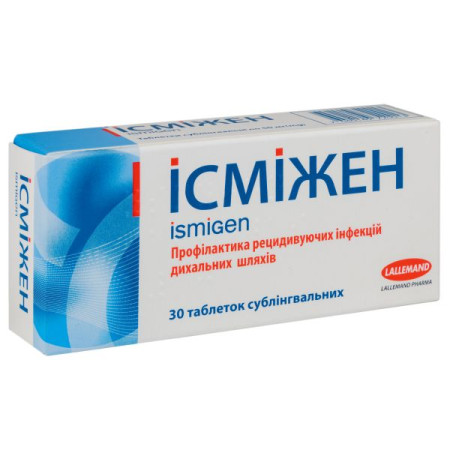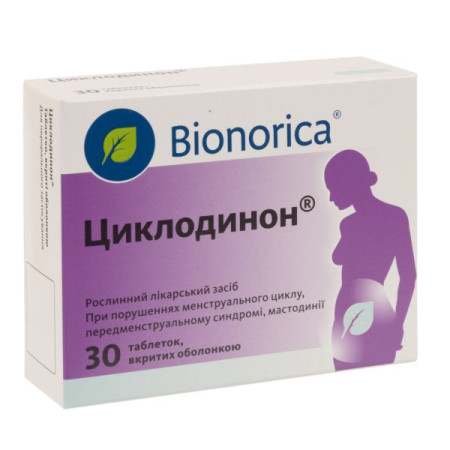Romazik film-coated tablets 10 mg No. 30
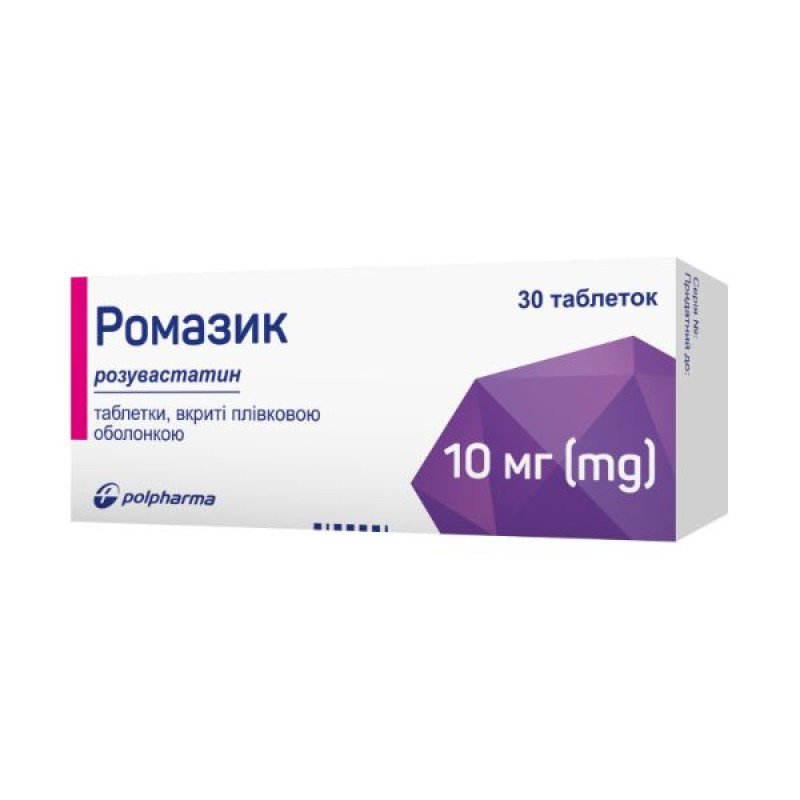
Instructions Romazik film-coated tablets 10 mg No. 30
Composition
active ingredient: rosuvastatin;
1 film-coated tablet contains 5 mg or 10 mg, or 20 mg, or 40 mg of rosuvastatin, which is equivalent to 5.2 mg or 10.4 mg, or 20.8 mg, or 41.6 mg of rosuvastatin calcium;
excipients: lactose monohydrate, type 1; lactose monohydrate, type 2; microcrystalline cellulose; sodium citrate; crospovidone type B; colloidal anhydrous silica; magnesium stearate; coating (dye Opadry II white 33G28523, hypromellose, lactose monohydrate, macrogol, triacetin, titanium dioxide (E 171)).
Dosage form
Film-coated tablets.
Main physicochemical properties:
5 mg: round, biconvex, film-coated tablets, white or almost white, embossed with “5” on one side;
10 mg: round, biconvex, film-coated tablets, white or almost white, embossed with “10” on one side;
20 mg: round, biconvex, film-coated tablets, white or almost white, embossed with “20” on one side;
40 mg: oblong biconvex tablets, film-coated, white or almost white.
Pharmacotherapeutic group
Lipid-lowering agents. HMG-CoA reductase inhibitors.
ATX code C10A A07.
Pharmacological properties
Pharmacodynamics
Rosuvastatin reduces elevated levels of LDL cholesterol, total cholesterol, and triglycerides, and also increases levels of HDL cholesterol (high-density lipoproteins).
The drug also reduces levels of apolipoprotein B (ApoB), non-LDL cholesterol, VLDL cholesterol, VLDL triglycerides and increases levels of apolipoprotein AI (ApoA-I) (see table).
Rosuvastatin also reduces the LDL-cholesterol/HDL-cholesterol ratio, total cholesterol/HDL-cholesterol, non-HDL-cholesterol/HDL-cholesterol, and ApoB/ApoA-I.
Table 1.
Dose response in patients with primary hypercholesterolemia (type IIa and IIb) (adjusted mean percent change from baseline)
| Dose | N | LDL-C | total cholesterol | X-HDL | TG | non-HDL-C | ApoB | ApoA-I |
| Placebo | 13 | 7 | -5 | 3 | 3 | -7 | 3 | 0 |
| 5 | 17 | 45 | 33 | 13 | 35 | 44 | 38 | 4 |
| 10 | 17 | 52 | 36 | 14 | 10 | 48 | 42 | 4 |
| 20 | 17 | 55 | 40 | 8 | 23 | 51 | 46 | 5 |
| 40 | 18 | 63 | 46 | 10 | 28 | 60 | 54 | 0 |
The therapeutic effect is achieved within 1 week after the start of treatment, and 90% of the maximum effect is achieved after 2 weeks. The maximum effect is usually achieved after 4 weeks and is maintained thereafter.
Pharmacokinetics
Absorption
The maximum concentration of rosuvastatin in blood plasma is reached approximately 5 hours after oral administration. Absolute bioavailability is approximately 20%.
Distribution
Rosuvastatin is extensively absorbed by the liver, which is the main site of cholesterol synthesis and LDL-cholesterol clearance. The volume of distribution of rosuvastatin is approximately 134 L. About 90% of rosuvastatin is bound to plasma proteins, mainly albumin.
Metabolism
Rosuvastatin undergoes limited metabolism (approximately 10%). In vitro metabolism studies using human hepatocytes indicate that rosuvastatin is a poor substrate for cytochrome P450-mediated metabolism. CYP2C9 is the major isoenzyme involved, with 2C19, 3A4 and 2D6 being involved to a lesser extent. The main metabolites identified are the N-desmethyl and lactone metabolites. The N-desmethyl metabolite is approximately 50% less active than rosuvastatin, and the lactone forms are considered clinically inactive. Rosuvastatin accounts for more than 90% of the HMG-CoA inhibitory activity in circulating blood.
Breeding
Approximately 90% of a dose of rosuvastatin is excreted unchanged in the feces (including absorbed and unabsorbed active substance), and the remainder is excreted in the urine.
Approximately 5% is excreted unchanged in the urine. The plasma half-life is approximately 19 hours. The half-life is not prolonged at higher doses. The geometric mean plasma clearance is approximately 50 l/hour (coefficient of variation 21.7%). As with other HMG-CoA reductase inhibitors, the membrane transporter OATP-C is involved in the hepatic uptake of rosuvastatin. This transporter plays an important role in the hepatic elimination of rosuvastatin.
Linearity
Systemic exposure to rosuvastatin increases in proportion to the dose. No changes in pharmacokinetic parameters are observed after multiple daily administration.
Separate groups
Age and gender
Age and gender do not have a clinically significant effect on the pharmacokinetics of rosuvastatin in adults. The pharmacokinetics of rosuvastatin in children and adolescents with heterozygous familial hypercholesterolemia were similar to those in adult volunteers (see section "Children").
Pharmacokinetic studies have shown an increase in mean AUC and Cmax in Mongoloid subjects (Japanese, Chinese, Filipinos, Vietnamese, and Koreans) compared to Caucasians; in Asians, mean AUC and Cmax are increased approximately 1.3-fold. Population pharmacokinetic analysis indicates no clinically significant differences in pharmacokinetics between Caucasians and Negroids.
Kidney dysfunction
In a study involving patients with varying degrees of renal impairment, mild to moderate renal disease had no effect on plasma concentrations of rosuvastatin and its N-desmethyl metabolite. In patients with severe renal impairment (creatinine clearance <30 ml/min), a 3-fold increase in plasma concentrations and a 9-fold increase in N-desmethyl metabolite concentrations were observed compared with healthy volunteers. Steady-state plasma concentrations of rosuvastatin in patients undergoing hemodialysis were approximately 50% higher than in healthy volunteers.
Liver dysfunction
In a study involving patients with varying degrees of hepatic impairment with a Child-Pugh score of 7 or less, systemic exposure to rosuvastatin was not increased. However, in 2 patients with Child-Pugh scores of 8 and 9, an increase in systemic exposure of at least 2-fold was observed compared to patients with lower Child-Pugh scores. There is no experience in patients with a Child-Pugh score above 9.
Children
Pharmacokinetic parameters in children with heterozygous familial hypercholesterolemia aged 10 to 17 years have not been fully studied. A small pharmacokinetic study of rosuvastatin (tablet form) in 18 children demonstrated that the drug exposure in children is comparable to that in adult patients. In addition, the results indicate the absence of a pronounced deviation from dose proportionality.
Indication
Treatment of hypercholesterolemia
Adults, adolescents and children aged 10 years and over with primary hypercholesterolemia (type IIa, including heterozygous familial hypercholesterolemia) or mixed dyslipidemia (type IIb) as an adjunct to diet when diet and other non-pharmacological measures (e.g. exercise, weight loss) are inadequate.
In homozygous familial hypercholesterolemia as an adjunct to diet and other lipid-lowering treatments (e.g. LDL apheresis) or in cases where such treatment is inappropriate.
Prevention of cardiovascular disorders
Prevention of major cardiovascular events in patients estimated to be at high risk of a first cardiovascular event (see section 5.1) as an adjunct to correction of other risk factors.
Contraindication
Hypersensitivity to rosuvastatin or to any of the excipients of the drug;
active liver disease, including persistent elevation of serum transaminases of unknown etiology, as well as elevation of any serum transaminase more than 3 times the upper limit of normal (ULN);
severe renal impairment (creatinine clearance < 30 ml/minute);
myopathy;
simultaneous use with cyclosporine;
during pregnancy or breastfeeding, as well as women of reproductive age who are not using adequate contraception.
The 40 mg dose is contraindicated in patients with factors predisposing to the development of myopathy/rhabdomyolysis. Such factors include:
moderate renal impairment (creatinine clearance < 60 ml/minute);
hypothyroidism;
hereditary diseases of the muscular system in personal or family history;
history of myotoxicity with another HMG-CoA reductase inhibitor or fibrate;
alcohol abuse;
conditions in which drug levels in blood plasma may increase;
belonging to the Mongoloid race;
concomitant use of fibrates
(see sections “Special instructions for use”, “Interaction with other medicinal products and other types of interactions” and “Pharmacokinetics”).
Interaction with other medicinal products and other types of interactions
Effect of concomitant medications on rosuvastatin
Transport protein inhibitors
Rosuvastatin is a substrate for several transport proteins, including the hepatic uptake transporter OATP1B1 and the efflux transporter BCRP. Concomitant use of rosuvastatin with medicinal products that inhibit these transport proteins may lead to increased plasma concentrations of rosuvastatin and an increased risk of myopathy (see sections 4.2, 4.4, and 4.5).
Cyclosporine
When rosuvastatin and cyclosporine were co-administered, rosuvastatin AUC values were on average 7 times higher than those in healthy volunteers. Rosuvastatin is contraindicated in patients receiving cyclosporine concomitantly (see section 4.3).
Concomitant use does not affect the concentration of cyclosporine in blood plasma.
Concomitant administration of rosuvastatin 10 mg and ezetimibe 10 mg to patients with hypercholesterolemia resulted in a 1.2-fold increase in rosuvastatin AUC (Table 2). However, a pharmacodynamic interaction between rosuvastatin and ezetimibe, which could lead to adverse reactions, cannot be excluded (see section 4.4).
Gemfibrozil and other lipid-lowering drugs
The simultaneous use of rosuvastatin and gemfibrozil leads to a 2-fold increase in Cmax and AUC of rosuvastatin (see section "Special instructions").
Based on data from specific interaction studies, no significant pharmacokinetic interaction with fenofibrate is expected, but a pharmacodynamic interaction may occur.
Gemfibrozil, fenofibrate, other fibrates and niacin (nicotinic acid) in lipid-lowering doses (doses greater than or equal to 1 g/day) increased the risk of myopathy when used concomitantly with HMG-CoA reductase inhibitors, possibly because the latter can cause myopathy when used alone. The 40 mg dose is contraindicated with concomitant use of fibrates (see sections 4.3 and 4.4). Patients should also be started on the 5 mg dose.
Protease inhibitors
Although the exact mechanism of interaction is unknown, concomitant use of protease inhibitors may significantly increase rosuvastatin exposure (see Table 2). For example, in a pharmacokinetic study, co-administration of 10 mg of rosuvastatin and a combination product containing two protease inhibitors (300 mg atazanavir/100 mg ritonavir) in healthy volunteers was accompanied by an increase in rosuvastatin AUC and Cmax by approximately 3- and 7-fold, respectively. Concomitant use of rosuvastatin and some combinations of protease inhibitors is possible after careful consideration of rosuvastatin dose adjustment based on the expected increase in rosuvastatin exposure (see sections “Method of administration and dosage”, “Special instructions for use”, “Interaction with other medicinal products and other forms of interaction”, Table 2).
Antacids
Concomitant administration of rosuvastatin and an antacid suspension containing aluminum and magnesium hydroxide resulted in a decrease in plasma concentrations of rosuvastatin by approximately 50%. This effect was less pronounced when the antacid was administered 2 hours after rosuvastatin administration. The clinical significance of this interaction has not been studied.
Erythromycin
Concomitant use of rosuvastatin and erythromycin results in a 20% decrease in rosuvastatin AUC (0-t) and a 30% decrease in rosuvastatin Cmax. This interaction may be due to increased intestinal motility as a result of erythromycin.
Cytochrome P 450 enzymes
In vitro and in vivo studies have shown that rosuvastatin does not inhibit or induce cytochrome P450 isoenzymes. In addition, rosuvastatin is a weak substrate for these isoenzymes. No clinically significant interactions were observed between rosuvastatin and fluconazole (a CYP2C9 and CYP3A4 inhibitor) and ketoconazole (a CYP2A6 and CYP3A4 inhibitor).
Interactions requiring dose adjustment of rosuvastatin
If it is necessary to use the drug Romazik with other drugs that can increase the exposure of rosuvastatin, the dose of the drug should be adjusted. If it is expected that the exposure of the drug (AUC) will increase by approximately 2 or more times, the use of Romazik should be started at a dose of 5 mg 1 time per day. The maximum daily dose of the drug should be adjusted so that the expected exposure of rosuvastatin does not exceed the exposure observed when taking a dose of 40 mg / day without the use of drugs that interact with the drug; for example, when used with gemfibrozil, the dose of rosuvastatin will be 20 mg (an increase in exposure of 1.9 times), when used with the combination of ritonavir / atazanavir - 10 mg (an increase of 3.1 times), When used simultaneously with cyclosporine - 5 mg (an increase of 7.1 times).
Table 2
Effect of concomitant medications on rosuvastatin exposure
(AUC; in descending order of magnitude) from published clinical trial data
| Dosing regimen of the interacting drug | Rosuvastatin dosage regimen | Changes in rosuvastatin AUC* |
| Cyclosporine 75 mg twice daily to 200 mg twice daily, 6 months | 10 mg once daily, 10 days | ↑ 7.1 times |
| Atazanavir 300 mg/ritonavir 100 mg once daily, 8 days | 10 mg, single dose | ↑ 3.1 times |
| Simeprivir 150 mg once daily, 7 days | 10 mg, single dose | ↑ 2.8 times |
| Lopinavir 400 mg/ritonavir 100 mg twice daily, 17 days | 20 mg once daily, 7 days | ↑ 2.1 times |
| Gemfibrozil 600 mg twice daily, 7 days | 80 mg, single dose | ↑ 1.9 times |
| Eltrombopac 75 mg once daily, 5 days | 10 mg, single dose | ↑ 1.6 times |
| Darunavir 600 mg/ritonavir 100 mg twice daily, 7 days | 10 mg once daily, 7 days | ↑ 1.5 times |
| Tipranavir 500 mg/ritonavir 200 mg twice daily, 11 days | 10 mg, single dose | ↑ 1.4 times |
| Dronedarone 400 mg twice daily | Not known | ↑ 1.4 times |
| Itraconazole 200 mg once daily, 5 days | 10 mg, single dose | ↑ 1.4 times ** |
| Ezetimibe 10 mg once daily, 14 days | 10 mg once daily, 14 days | ↑ 1.2 times ** |
| 10 mg, single dose | ↔ | |
| Aleglitazar 0.3 mg, 7 days | 40 mg, 7 days | ↔ |
| Silymarin 140 mg three times a day, 5 days | 10 mg, single dose | ↔ |
| Fenofibrate 67 mg three times a day, 7 days | 10 mg, 7 days | ↔ |
| Rifampin 450 mg once daily, 7 days | 20 mg, single dose | ↔ |
| Ketoconazole 200 mg twice daily, 7 days | 80 mg, single dose | ↔ |
| Fluconazole 200 mg once daily, 11 days | 80 mg, single dose | ↔ |
| Erythromycin 500 mg 4 times a day, 7 days | 80 mg, single dose | ↓ 20% |
| Baicalin 50 mg three times a day, 14 days | 20 mg, single dose | ↓ 47% |
| Regorafenib 160 mg, once daily, 14 days | 5 mg single dose | ↑ 3.8 times |
| Velpatasvir 100 mg, once daily | 10 mg single dose | ↑ 2.7 times |
Ombitasvir 25 mg/paritaprevir 150 mg/ Ritonavir 100 mg once daily/dasabuvir 400 mg twice daily, 14 days | 5 mg single dose | ↑ 2.6 times |
| Grazoprevir 200 mg/Elbasvir 50 mg once daily, 11 days | 10 mg single dose | ↑ 2.3 times |
| Glecaprevir 400 mg/pibrentasvir 120 mg once daily, 7 days | 5 mg once daily, 7 days | ↑ 2.2 times |
* Data presented as x-fold change represents the ratio between rosuvastatin in combination and alone. Data presented as % change represents the % difference relative to rosuvastatin alone.
Increase is indicated by ↑, no change by ↔, decrease by ↓.
** Several interaction studies have been conducted at different doses of rosuvastatin, the most significant relationship is shown in the table.
Effect of rosuvastatin on concomitant medications
Vitamin K antagonists
As with other HMG-CoA reductase inhibitors, when initiating rosuvastatin or increasing its dose in patients concomitantly receiving vitamin K antagonists (e.g. warfarin or another coumarin anticoagulant), an increase in the International Normalized Ratio (INR) may occur. Discontinuation of rosuvastatin or dose reduction may result in a decrease in INR. In such cases, appropriate monitoring of INR is advisable.
Oral contraceptives/hormone replacement therapy (HRT)
Concomitant use of rosuvastatin and oral contraceptives leads to an increase in the AUC of estradiol and norgestrel by 26% and 34%, respectively. This increase in plasma concentrations should be taken into account when selecting doses of oral contraceptives. There are no pharmacokinetic data on patients taking rosuvastatin and HRT at the same time, so a similar effect cannot be excluded. However, this combination has been widely used in clinical trials and has been well tolerated by patients.
Other medicines
Based on data from specific interaction studies, no clinically significant interaction with digoxin is expected.
Lopinavir/ritonavir
In a pharmacology study, co-administration of rosuvastatin and a combination product containing two protease inhibitors (lopinavir 400 mg/ritonavir 100 mg) in healthy volunteers was associated with an approximately two-fold and five-fold increase in steady-state AUC(0-24) and Cmax of rosuvastatin, respectively. Interactions between rosuvastatin and other protease inhibitors have not been studied.
Fusidic acid.
The risk of myopathy, including rhabdomyolysis, may be increased when fusidic acid is administered concomitantly with statins. The mechanism of this interaction (pharmacodynamic, pharmacokinetic, or both pharmacodynamic and pharmacokinetic) is still unknown. There have been reports of rhabdomyolysis (including rare fatal cases) in patients receiving this combination.
If systemic use of fusidic acid is necessary, rosuvastatin treatment should be discontinued for the duration of fusidic acid administration (see section 4.4).
Ticagrelor
Ticagrelor may cause renal failure and may affect the renal excretion of rosuvastatin, increasing the risk of its accumulation. In some cases, the combined use of ticagrelor and rosuvastatin has led to decreased renal function, increased creatine phosphokinase (CPK) levels, and rhabdomyolysis. It is recommended to monitor renal function and CPK levels when ticagrelor and rosuvastatin are used concomitantly.
Children
Interaction studies have only been performed in adult patients. The extent of interaction in children is unknown.
Application features
Effects on the kidneys
Proteinuria (detected by dipstick), usually of tubular origin, has been observed in patients treated with rosuvastatin at the highest doses, particularly 40 mg, and was in most cases transient or short-lived. Proteinuria was not predictive of acute or progressive renal disease, and renal function testing should be considered in patients receiving the 40 mg dose.
Effects on skeletal muscles
Very rare cases of rhabdomyolysis have been reported with the use of ezetimibe in combination with HMG-CoA reductase inhibitors. A pharmacodynamic interaction cannot be excluded; such combination therapy should be used with caution.
As with other HMG-CoA reductase inhibitors, rhabdomyolysis associated with rosuvastatin treatment has been reported more frequently in post-marketing experience at doses of 40 mg. Rare cases of immune-mediated necrotizing myopathy, clinically manifested by persistent proximal muscle weakness and elevated serum creatine kinase, have been reported during or after discontinuation of statins, including rosuvastatin. In such cases, additional neuromuscular and serological testing and immunosuppressive therapy may be warranted.
Cases of de novo or exacerbation of pre-existing myasthenia gravis or ocular myasthenia have been reported with statin use (see section 4.8). Romazik should be discontinued if symptoms worsen. Relapses have been reported after re-administration of the same or a different statin.
Determination of creatine kinase level
Creatine kinase (CK) levels should not be measured after strenuous exercise or in the presence of other plausible causes of elevated CK, which may lead to misinterpretation of the results. If initial CK levels are significantly elevated (more than 5 times the upper limit of normal), a repeat test should be performed after 5–7 days. Therapy with the drug should not be initiated if the repeat test confirms that the initial CK level is more than 5 times the upper limit of normal.
Before treatment
Rosuvastatin, like other HMG-CoA reductase inhibitors, should be administered with caution to patients with predisposing factors for the development of myopathy/rhabdomyolysis. Such factors include:
kidney dysfunction;
hypothyroidism;
hereditary diseases of the muscular system in personal or family history;
history of myotoxicity with another HMG-CoA reductase inhibitor or fibrate;
alcohol abuse;
age > 70 years;
conditions in which plasma levels of the drug may increase (see sections “Method of administration and dosage”, “Interaction with other medicinal products and other types of interactions” and “Pharmacokinetics”);
simultaneous use of fibrates.
In such patients, the risks of treatment should be weighed against the potential benefits, and clinical monitoring is recommended. If baseline CK levels are significantly elevated (more than 5 times the upper limit of normal), treatment should not be initiated.
During treatment
Patients should be advised to seek medical advice immediately if they experience sudden onset of muscle pain, weakness or cramps, especially if associated with malaise or fever. In such patients, CK levels should be measured. Treatment should be discontinued if CK levels are significantly elevated (more than 5 times the upper limit of normal) or if symptoms are severe and cause daily discomfort (even if CK levels are less than 5 times the upper limit of normal). If symptoms resolve and CK levels return to normal, consideration should be given to reintroducing rosuvastatin or an alternative HMG-CoA reductase inhibitor at the lowest dose and under close observation.
There is no need to routinely monitor CK levels in asymptomatic patients. Very rare cases of immune-mediated necrotizing myopathy (IMNM) have been reported during or after treatment with statins, including rosuvastatin. Clinical manifestations of IMNM include proximal muscle weakness and elevated serum creatine kinase, which persist even after discontinuation of statins.
In studies, there was no evidence of increased skeletal muscle effects in a small number of patients receiving rosuvastatin and concomitant therapy. However, an increased incidence of myositis and myopathy has been observed in patients receiving other HMG-CoA reductase inhibitors concomitantly with fibric acid derivatives, including gemfibrozil, cyclosporine, nicotinic acid, azole antifungals, protease inhibitors, and macrolide antibiotics. Gemfibrozil increases the risk of myopathy when used concomitantly with some HMG-CoA reductase inhibitors. Therefore, the combination of rosuvastatin and gemfibrozil is not recommended.
Rosuvastatin should not be used concomitantly with systemic fusidic acid-containing products and within 7 days of stopping fusidic acid. Patients requiring systemic fusidic acid should discontinue statins for this period. Rhabdomyolysis (including rare fatal cases) has been reported in patients receiving fusidic acid in combination with statins. Patients should seek medical advice immediately if they experience symptoms of muscle weakness or muscle pain.
Statin therapy can be resumed 7 days after the last dose of fusidic acid.
In exceptional cases, if prolonged systemic use of fusidic acid is required, for example, for the treatment of severe infections, the need for the simultaneous use of rosuvastatin and fusidic acid should be considered in detail on a case-by-case basis under close medical supervision.
Rosuvastatin should not be used in patients with acute serious conditions that may indicate myopathy or provoke the development of renal failure due to rhabdomyolysis (such as sepsis, arterial hypotension, major surgery, trauma, severe metabolic, endocrine or electrolyte disorders; uncontrolled epileptic seizures).
Effect on the liver
As with other HMG-CoA reductase inhibitors, rosuvastatin should be used with caution in patients who abuse alcohol and/or have a history of liver disease.
It is recommended to check liver function tests before starting treatment and 3 months after starting treatment. Rosuvastatin should be discontinued or the dose reduced if serum transaminase levels exceed 3 times the upper limit of normal. During post-marketing use, serious liver reactions (mainly increases in serum transaminases) have been reported more frequently with the 40 mg dose.
In patients with secondary hypercholesterolemia due to hypothyroidism or nephrotic syndrome, the underlying disease should be treated before starting rosuvastatin.
In the post-marketing period, fatal or non-fatal cases of hepatic failure have been reported rarely in patients taking statins, including rosuvastatin. If serious liver damage with clinical symptoms and/or hyperbilirubinemia or jaundice develops during treatment with rosuvastatin, the drug should be discontinued immediately. Unless other causes are identified, treatment with rosuvastatin should not be resumed.
Race
Pharmacokinetic studies indicate increased exposure in representatives of the Mongoloid race compared with representatives of the Caucasian race. For such patients, dosage adjustment of rosuvastatin is necessary (see sections "Method of administration and dosage", "Contraindications" and "Pharmacokinetics"). For patients of the Asian race, the initial dose of Romazik should be 5 mg. Increased plasma concentrations of rosuvastatin have been observed in Asian patients (see sections "Special instructions" and "Pharmacokinetics"). Increased systemic exposure should be taken into account when treating patients of the Mongoloid race, in whom hypercholesterolemia is not adequately controlled with doses up to 20 mg.
Protease inhibitors
Increased systemic exposure to rosuvastatin has been observed in subjects receiving rosuvastatin concomitantly with various protease inhibitors in combination with ritonavir. The benefit of lipid-lowering effects of rosuvastatin in HIV patients receiving protease inhibitors should be considered, as well as the possibility of increased plasma concentrations of rosuvastatin at the start of therapy and with an increase in the dose of Romazik in patients receiving protease inhibitors. Co-administration of the drug with protease inhibitors is not recommended unless the dose of Romazik is adjusted (see sections 4.2 and 4.5).
Interstitial lung disease
Exceptional cases of interstitial lung disease have been reported with some statins, especially with long-term treatment (see section 4.8). Manifestations may include dyspnoea, non-productive cough and deterioration in general condition (weakness, weight loss and fever). If interstitial lung disease is suspected in a patient, statin treatment should be discontinued.
Diabetes mellitus
As with other HMG-CoA reductase inhibitors, increases in HbA1c and serum glucose levels have been observed with rosuvastatin. In some cases, these values may exceed the threshold for diagnosing diabetes mellitus, especially in patients at high risk of developing diabetes.
In clinical studies, rosuvastatin as monotherapy did not cause a decrease in basal plasma cortisol concentrations and did not affect adrenal reserve. Caution is required when rosuvastatin is used concomitantly with other drugs that may reduce the levels or activity of endogenous steroid hormones, such as ketoconazole, spironolactone and cimetidine.
Severe skin adverse reactions
Severe cutaneous adverse reactions, including Stevens-Johnson syndrome and drug-induced eosinophilia with systemic symptoms (DRESS), which can be life-threatening or fatal, have been reported with rosuvastatin. Patients should be informed of the signs and symptoms of severe skin reactions and monitored closely when prescribing rosuvastatin. If signs and symptoms suggestive of this reaction occur, the drug should be discontinued immediately and alternative treatment should be considered. If a patient develops a serious reaction such as Stevens-Johnson syndrome and drug-induced eosinophilia with systemic symptoms (DRESS), treatment with the drug should be discontinued immediately and never used again.
Children
Assessment of linear growth (height), body weight, BMI (body mass index) and secondary sexual maturation characteristics according to Tanner in children aged 10 to 17 years who took rosuvastatin was limited to a period of 1 year. After 52 weeks of study treatment, no effect on growth, body weight, BMI or sexual maturation was observed (see section "Pharmacodynamics"). Clinical trial experience in children and adolescents is limited, and the long-term effects of rosuvastatin use (> 1 year) on sexual maturation are unknown.
In a clinical study in children and adolescents taking rosuvastatin for 52 weeks, increases in CK levels > 10 times the upper limit of normal and muscle symptoms after exercise or increased physical activity were observed more frequently compared to those in adults (see section "Adverse reactions").
Lactose intolerance
Patients with rare conditions such as galactose intolerance, the Lapp lactase deficiency or glucose-galactose malabsorption should not take this medicine.
Use during pregnancy or breastfeeding
Rosuvastatin is contraindicated during pregnancy or breastfeeding.
Women of reproductive age should use adequate contraception.
Since cholesterol and other cholesterol biosynthesis products are essential for fetal development, the potential risk of HMG-CoA reductase inhibition outweighs the potential benefit of using the drug during pregnancy. Animal data on reproductive toxicity are limited.
If pregnancy occurs during the use of this drug, treatment should be discontinued immediately.
Because another drug of this class is excreted in human milk and because HMG-CoA reductase inhibitors can cause serious adverse reactions in nursing infants, women who require treatment with Romazik should be advised not to breast-feed. There are no data on the excretion of the drug in human milk (see section 4.3).
Ability to influence reaction speed when driving vehicles or other mechanisms
Studies to determine the effect of rosuvastatin on the ability to drive or operate other mechanisms have not been conducted.
When driving vehicles or using other mechanisms, it is necessary to take into account the possibility of dizziness during treatment.
There are no reviews for this product.
There are no reviews for this product, be the first to leave your review.
No questions about this product, be the first and ask your question.




